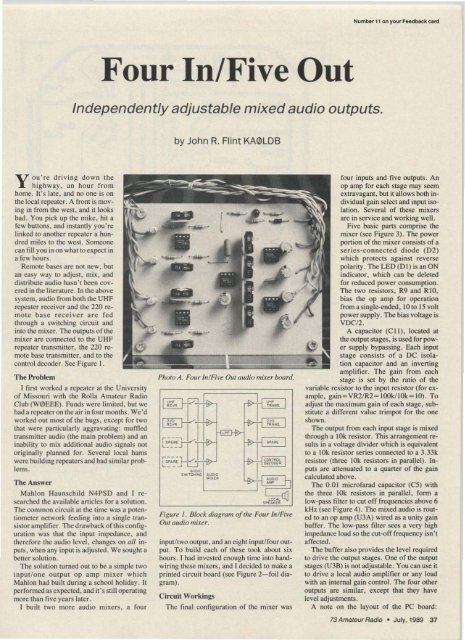am..Brew
T'JTJ~~~ - Free and Open Source Software
T'JTJ~~~ - Free and Open Source Software
- No tags were found...
You also want an ePaper? Increase the reach of your titles
YUMPU automatically turns print PDFs into web optimized ePapers that Google loves.
Number 11 on your Feedback c. rd<br />
Four In/Five Out<br />
Independently adjustable mixed audio outputs.<br />
by John R. Flint KA0 LDB<br />
Y<br />
o<br />
u ' re d riv ing down Ihe<br />
hig hway , a n hou r from<br />
home. Ir's late, and no o ne is on<br />
the local repeater. A front is moving<br />
in from the west, and it looks<br />
bad . You pick up the mike, hit a<br />
few buttons, and instantly you're<br />
linked to another repeater a hundred<br />
miles to the west. Someone<br />
can fill you in on what to expect in<br />
a few hours.<br />
Remote bases are not new, but<br />
an easy way to adjust, mix, and<br />
d istribute aud io hasn 't bee n covered<br />
in the literature. In the above<br />
system, audio from both the UHF<br />
repeater receiver and the 220 remole<br />
base recei ver are fed<br />
through a switching ci rcuit and<br />
into the mixer. The output s o f the<br />
mixer are connected to the UHF<br />
repeater transmitter, the 220 remote<br />
base transmitter, and to the<br />
control decoder. See Figure I .<br />
The Problem<br />
I first worked a repeater at the University<br />
of Missouri with the Rolla Amateur Radio<br />
Club (W0 EEE). Funds were limi ted , but we<br />
had a repeater on the air in four months. We'd<br />
worked out most of the bugs, except for two<br />
that were particularly aggravating: muffled<br />
transmitter audio (the main problem) and an<br />
inability to mix additional aud io signals not<br />
o rigi nally planned for. Several local h<strong>am</strong>s<br />
were building repeaters and had similar problems.<br />
The Answer<br />
Mahlon Haunschild N4PSD and I re <br />
searched the available anicles for a solution.<br />
The common circuit at the time was a potentiometer<br />
network feeding into a single transistor<br />
<strong>am</strong>plifier. The drawback ofthis configuration<br />
was that the input impedance , and<br />
therefore the audio level, changes on all inputs,<br />
when any input is adjusted. We sought a<br />
better solution.<br />
The solution turned out to be a simple two<br />
input/one ou tp ut op <strong>am</strong>p mixer which<br />
Mahlon had bui lt during a school holiday. It<br />
performed as expected, and it' s still operating<br />
more than five years later.<br />
I built two more audio mixers, a four<br />
Photo A. Four In/Five Our audio mixer board.<br />
I f-P' ,~ I~ I<br />
RCvR<br />
~~~ 5 I<br />
Ilrt<br />
,.---- ...<br />
'S ~UEW<br />
~~ I<br />
~~~~, I I<br />
COOITACII-,<br />
_.<br />
S",TC>[R<br />
4>- H ~ ' O h<br />
c~""<br />
Vt:""

















